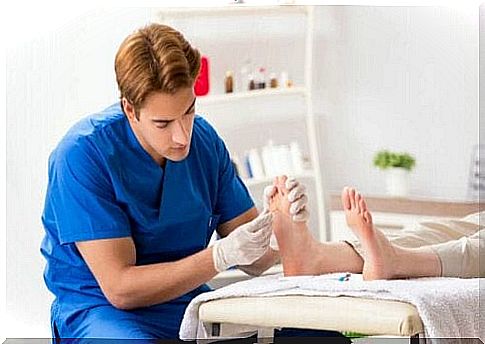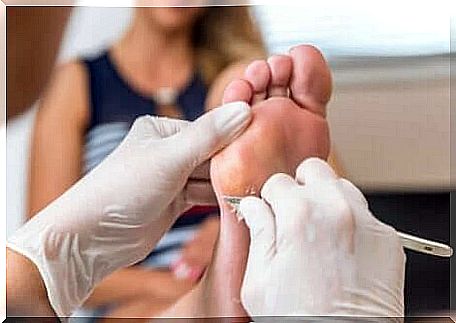When Should We Consult A Podiatrist?
The podiatrist is a health professional who takes care of the vitality of our feet. It is important to go and consult him for treatment as well as to start preventive practices. Learn more about it in this article.

Even if we frequently consult a podiatrist for pain or discomfort, its function can also be preventive. Podiatry is able to prevent foot lesions before they appear.
This area of health studies the feet in their anatomical and physiological context. It goes well beyond the famous horns and the biometric study of the stride. This is a specialty that considers the lower limbs as a functional whole.
The podiatrist has the ability to prevent, diagnose, treat and re-educate the feet, correcting disorders, preventing their appearance and reconditioning the stride. To be a podiatrist, you must have a license in some countries and a university degree in others.
Usual reasons for consultation with the podiatrist
As we mentioned, podiatry is not a science that boils down to treating corns. Different areas of daily life affect the anatomy and physiology of the foot, and this is where the podiatrist can put their knowledge into practice.
The most common reason for consultation is still pain or discomfort. When we feel that our feet hurt too much, that they bother us when we walk or when we see a lesion, we go to the podiatrist.
However, we can consult him without the slightest lesion. For example, if we are going to start a sport, or if we have been practicing it for a long time, the podiatrist can advise us. The step is forced and overloaded when practicing sports, and a podiatrist can correct bad positions to prevent us from injuring ourselves.
There is also the possibility of requesting a biometric test of the stride. Through measurements and with devices, the podiatrist will determine how the base of our foot is, where it leans the most and how it could injure itself if it was not corrected.

Disorders that podiatry can treat
The podiatrist can treat diseases that already exist in the foot. He sometimes does it jointly with a general practitioner or a traumatologist, and other times with his own expertise.
Podiatry can treat:
- Repetitive injuries: There are people who frequently injure their feet or the ankle joint. This can be the result of a bad stride. By evaluating the foot biometrically, it is possible to correct poor support.
- Poor support from old age: As you age, the bones of the foot become more fragile and become deformed, which changes the way you walk. A podiatrist can advise the elderly and their guardians to improve their walking dynamics and prevent falls.
- Ingrown toenails: they are corrected with minimally invasive operations that are done in a few minutes, under local anesthesia.
- Flatfoot: Flatfoot is a condition where the internal arch of the foot is not fully formed. It can be painful if you don’t wear the right shoes.
- Corns: Corns are treated by podiatrists with special instruments.
- Hammer toes: Some people suffer from deformities of the toes. The most common is that of the hammer toe, which consists of a finger that folds back on itself. This changes the stride, alters the use of the shoes and creates corns.
- Bromhidrosis: this is the name given to the intense smell of the feet due to a failure in the glands of the lower limbs. Sometimes there are concomitant infections that contribute to the bad smell, and other times the problem is only genetic.

Treatments performed by the podiatrist
The podiatrist can carry out treatments if he detects an alteration that is within the reach of his knowledge. One of the indications that these professionals use the most is the use of insoles.
The insoles are orthopedic treatments, that is to say, which seek to correct deviations in the axis of the posture. By improving posture, pain and joint problems are avoided.
Even though there are insoles which can be acquired freely in the trade, this is not recommended. Ideally, the podiatrist takes measurements of the foot to indicate the sole that corresponds to each person. Pitch is an individual characteristic that is not shared in the same way in all human beings.
If necessary, the podiatrist can also carry out small operations. As we said, ingrown toenail and corns can be treated with basic instruments. You just need local anesthesia.
Follow-up is also important in podiatry. The feet can return to a bad position and ingrown toenails can come back, as can corns. The podiatrist then schedules appointments to monitor his treatments and reassess them.








